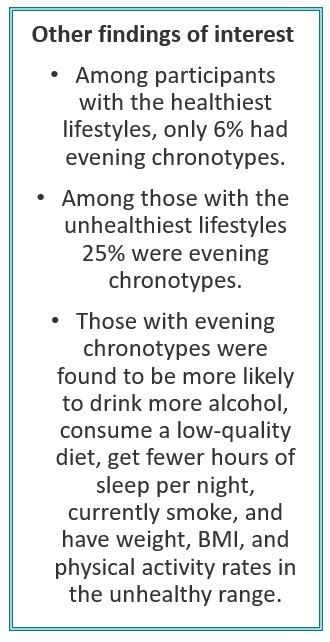Evening Chronotype in Women Linked with Unhealthy Lifestyle, Increased Risk for Type 2 Diabetes
An individual chronotype that favors later sleep and wake patterns may be associated with less healthy lifestyle choices and also with increased risk for type 2 diabetes (T2D), according to new research from Brigham and Women’s Hospital and Harvard Medical School.
When investigators compared women from the Nurses’ Health Study (NHS) II with a “definite evening” chronotype with those who had a “definite morning” chronotype, the former were 54% more likely to exhibit an unhealthy lifestyle pattern and were at a 72% greater risk of developing T2D. While adjustments made for all lifestyle factors measured in the study reduced the positive association, there was still a 19% greater risk for T2D among the group of “night owls.” The findings were reported online September 12, 2023, in the Annals of Internal Medicine.
©Joshua Resnick/stock.adobe.com

The night owls may benefit from closer attention to behavioral lifestyle factors, said corresponding author Tianyi Huang, MSc, ScD, an associate epidemiologist in the Brigham’s Channing Division of Network Medicine, in a BWH statement.2 He added, however, that there is a genetic component to an individual’s circadian preference which could make it difficult to shift the pattern.
In previous research, Huang and colleagues have observed an association between irregular sleep schedules and higher risk for developing diabetes and cardiovascular disease. They found, as well, that variable sleep patterns are more common among individuals with evening chronotypes.2
The objective of their current study was to assess the role that modifiable lifestyle behaviors may play in the association between chronotype and risk for T2D.1
Data were obtained for women participating in the prospective NHS II (initiated in 1989). Study participants, women aged 25 to 42 years and predominantly White, employed as registered nurses, were required to complete comprehensive questionnaires about lifestyle and provide health-related information at baseline and every 2 years. Excluding from the original cohort of 116 429 those with a history of cardiovascular disease, cancer, or diabetes, Huang and colleagues identified 63 676 nurses with follow-up between 2009-2017 for the analyses. Mean age of this final group was 54 years; 97% were White; and 67% were postmenopausal, according to the study.1
Participant chronotype was self-reported using a validated questionnaire. Lifestyle behaviors selected for measurement were diet quality, physical activity, alcohol intake, body mass index (BMI), smoking, and sleep duration. Incident cases of diabetes also were self-reported and were confirmed with a supplementary questionnaire.
FINDINGS1
Investigators reported that, among the cohort of 63 676, there were 22 380 participants (~35%) with a definite morning chronotype, 34 167 (~50%) with a an intermediate chronotype, and 7129 (~11%) with a definite evening chronotype.
While they found similar distributions of age and race across chronotypes, Huang et al reported several notable differences, eg, participants with a definite evening chronotype were more likely to have ever worked night shifts, to have worked any rotating night shift work in the previous 2 years, and to have depression. Further, unhealthy lifestyle behaviors were more common among participants with a definite evening vs morning chronotype.
Chronotype, lifestyle, and T2D1
Analysis of the relationship between chronotype and lifestyle found that the circadian preference for later bedtimes and sleeping in was associated with a 54% greater risk of having an unhealthy lifestyle compared to the definite morning chronotype (adjusted prevalence ratio, 1.54; 95% CI, 1.49-1.59).

The researchers reported 1925 cases of incident T2D during 469 120 person-years of follow-up. After making adjustments for sociodemographic factors, shift work, and family history of diabetes, their comparison with the group of participants with a definite morning chronotype revealed a 72% increased risk for T2D among those with an evening chronotype (95% CI, 1.50-1.98) and a 21% greater risk among those identified as having an intermediate chronotype (95% CI, 1.09-1.35).
When they adjusted further, for BMI, physical activity, and diet quality, Huang and colleagues reported a somewhat attenuated association with T2D comparing definite evening and definite morning chronotypes of 1.31 (95% CI, 1.13-1.50), 1.54 (95% CI, 1.34-1.77), and 1.59 (95% CI, 1.38-1.83), respectively1
After adjusting for all measured lifestyle and sociodemographic factors, the increase in risk for T2D for those with evening vs morning chronotype was reduced but remained positive at 19% (95% CI, 1.03-1.37).1
“When we controlled for unhealthy lifestyle behaviors, the strong association between chronotype and diabetes risk was reduced but still remained, which means that lifestyle factors explain a notable proportion of this association,” said first author Sina Kianersi, DVM, PhD, a postdoctoral research fellow in the Brigham’s Channing Division of Network Medicine, in the press statement.2
“If we are able to determine a causal link between chronotype and diabetes or other diseases, physicians could better tailor prevention strategies for their patients,” added Kianersi.
References
1. Kianersi S, Liu Y, Guasch-Ferré M, et al. Chronotype, unhealthy lifestyle, and diabetes risk in middle-aged U.S. women: a prospective cohort study. Ann Intern Med. Published online September 12, 2023. doi:10.7326/M23-0728
2. “Night owls” more likely than “early birds” to develop diabetes. Brigham and Women's Hospital, EurekAlert! September 11, 2023. Accessed September 12, 2023. https://www.eurekalert.org/news-releases/1000853
.